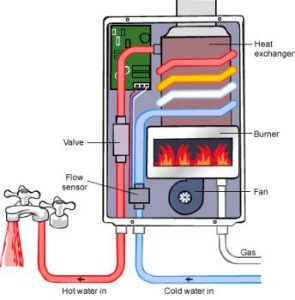7.1 Combining theory and practice elementary: exercises (examples)
Course subject(s)
7. Transport phenomena in the world around us
HOT WATER IN YOUR HOUSE
Where is the hot water heater in your house? The hot water heater of Julia’s house in Delft is in the attic.

The kitchen is some distance away, on the opposite side of the house. When the hot water tap in the kitchen is turned on, it takes about 20 seconds for the hot water to arrive from the heater. In that time, 2.5 litres of cold water from the hot water tap can be collected. The diameter of the copper pipe delivering water from the heater to the kitchen is 10 mm. The pipe is in the open air.
Exercise 2
HEAT EXCHANGER
A heat exchanger consist of a bundle of horizontal tubes. Water, which has to be heated for heating purposes, flows through these tubes. The inlet temperature of the water is 70 °C. Flue gas is used for heating up the water. This flows past the tubes in a vertical direction and has a temperature of 400 °C .
To determine the overall heat transfer coefficient for heat transfer of the flue gas to the water, the liquid from one tube is being collected in a small mixing barrel, placed directly after the tube, after a certain amount of time. During this experiment, the entire process is steady state. We assume that this overall heat transfer coefficient is independent on the position inside the heat exchanger.
Data
– Length tube: 0.60 m.
– Density water: 960 kg/m3
– Inside tube diameter: 4.0 cm
– Dynamic viscosity: 4.0 * 10-4 Ns/m2
– Heat capacity: 4.0 kJ/kgK (applies to water of 70 °C to 90 °C)

The Basics of transport phenomena by TU Delft OpenCourseWare is licensed under a Creative Commons Attribution-NonCommercial-ShareAlike 4.0 International License.
Based on a work at https://ocw.tudelft.nl/courses/basics-transport-phenomena/.



